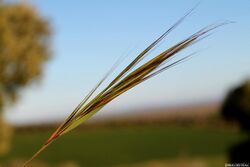Biology:Stipa
| Stipa | |
|---|---|

| |
| Mediterranean needle-grass, Stipa capensis | |
| Scientific classification | |
| Kingdom: | Plantae |
| Clade: | Tracheophytes |
| Clade: | Angiosperms |
| Clade: | Monocots |
| Clade: | Commelinids |
| Order: | Poales |
| Family: | Poaceae |
| Subfamily: | Pooideae |
| Supertribe: | Stipodae |
| Tribe: | Stipeae |
| Genus: | Stipa L.[1] |
| Species | |
|
Some 300, see text. | |
| Synonyms | |
| |
Stipa is a genus of around 300 large perennial hermaphroditic grasses collectively known as feather grass, needle grass, and spear grass. They are placed in the subfamily Pooideae and the tribe Stipeae, which also contains many species formerly assigned to Stipa, which have since been reclassified into new genera.
Many species are important forage crops. Several species such as Stipa brachytricha, S. arundinacea, S. splendens, S. calamagrostis, S. gigantea and S. pulchra are used as ornamental plants. One former species, esparto grass (Macrochloa tenacissima), is used for crafts and extensively in paper making.
It is a coarse grass with inrolled leaves and a panicle patterned inflorescence.[2]
Ecology
Species of the genus Stipa can occur in grasslands[3] or in savanna habitats. Certain specific prairie plant associations are dominated by grasses of the genus Stipa, which genus often lends its name to the terminology of some prairie types.[4] In some areas of the western United States grasses of the genus Stipa form a significant part of the understory of Blue Oak savannas, and were even a more important element prehistorically before the invasion of many European grasses.[5]
Selected species
- Stipa avenacea – black oat grass
- Stipa baicalensis Roshev.
- Stipa barbata Desf.
- Stipa bavarica
- Stipa borysthenica
- Stipa brachytricha – Korean feather grass
- Stipa canadensis
- Stipa capensis
- Stipa capillata L.
- Stipa coreana Honda – Korean needlegrass[6]
- Stipa grandis P.A.Smirn.
- Stipa joannis Čelak.
- Stipa leptogluma
- Stipa mexicana
- Stipa milleana
- Stipa mollis
- Stipa pennata L. – feather grass
- Stipa pulcherrima
- Stipa speciosa
- Stipa tirsa Steven
- Stipa tulcanensis
- Stipa turkestanica Hack.
- Stipa zalesskii Wilensky
Formerly placed here
- Achnatherum calamagrostis (L.) P.Beauv. (as S. calamagrostis (L.) Wahlenb.)
- Achnatherum robustum (Vasey) Barkworth (as S. robusta (Vasey) Scribn.)
- Achnatherum splendens (Trin.) Nevski (as S. splendens Trin.)
- Celtica gigantea (Link) F. M. Vazquez & Barkworth (as S. gigantea Link)
- Eriocoma arida (as S. arida)
- Hesperostipa comata (as S. comata)
- Jarava ichu Ruiz & Pav. (as S. ichu (Ruiz & Pav.) Kunth)
- Macrochloa tenacissima (Loefl. ex L.) Kunth (as S. tenacissima Loefl. ex L.)
- Nassella leucotricha (Trin. & Rupr.) R.W.Pohl (as S. leucotricha Trin. & Rupr.)
- Nassella pulchra (Hitchc.) Barkworth (as S. pulchra Hitchc.)
- Oryzopsis hymenoides (Ricker.) (as S. hymenoides Roem. & Schult.)[7][8]
- Nassella viridula (Trin.) Barkworth (as S. viridula Trin.)[9]
- Hesperostipa spartea (Trin.) Barkworth (as Stipa spartea Trin.)[10]
- Anemanthele lessoniana (Steud.) Veldkamp (as Stipa arundinacea Hook.f.)[11]
See also
References
- ↑ 1.0 1.1 "Genus: Stipa L.". Germplasm Resources Information Network. United States Department of Agriculture. 1998-09-14. http://www.ars-grin.gov/cgi-bin/npgs/html/genus.pl?11604.
- ↑ Morley, Thomas (1966). Spring Flora of Minnesota. The University of Minnesota Press. p. 47.
- ↑ Elgaily Osman Ahmed, 1983
- ↑ Ecological Society of America, 1921
- ↑ *C. Michael Hogan, 2008
- ↑ English Names for Korean Native Plants. Pocheon: Korea National Arboretum. 2015. pp. 647. ISBN 978-89-97450-98-5. http://www.forest.go.kr/kna/special/download/English_Names_for_Korean_Native_Plants.pdf. Retrieved 24 December 2016.
- ↑ "Oryzopsis hymenoides | International Plant Names Index". https://www.ipni.org/n/176951-2.
- ↑ "GRIN Species Records of Stipa". Germplasm Resources Information Network. United States Department of Agriculture. http://www.ars-grin.gov/cgi-bin/npgs/html/splist.pl?11604.
- ↑ "Nassella viridula (Trin.) Barkworth | Plants of the World Online | Kew Science" (in en). http://powo.science.kew.org/taxon/urn:lsid:ipni.org:names:281187-2.
- ↑ "Hesperostipa spartea (Trin.) Barkworth | Plants of the World Online | Kew Science" (in en). http://powo.science.kew.org/taxon/urn:lsid:ipni.org:names:969795-1.
- ↑ "World Checklist of Selected Plant Families: Royal Botanic Gardens, Kew | Synonyms of Anemanthele lessoniana (Steud.) Veldkamp.". https://wcsp.science.kew.org/synonomy.do?name_id=393675.
External links
Wikidata ☰ Q161274 entry
 |

